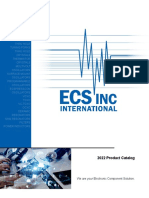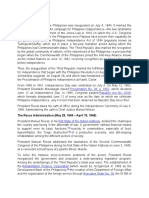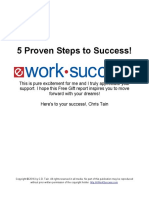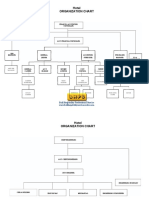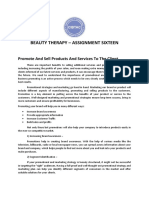ĐỀ ÔN KIỂM TRA CUỐI HỌC KÌ 1 – FORMAT 2025 - ĐỀ SỐ 10+
Read the following advertisement and mark the letter A, B, C, or D on your answer sheet to indicate the
option that best fits each of the numbered blanks from 1 to 6.
Career Development Workshop
Are you looking to advance in your career? Join our Career Boost Workshop! This intensive program is
designed to help professionals gain the skills needed to excel in today’s (1)___________.
Led by industry experts, the workshop covers essential topics like effective communication, leadership
strategies, and project management. Participants will have the chance to network with various like-minded
individuals, building valuable (2)______ connections. Our program is held at a state-of-the-art facility (3)______
to accommodate interactive sessions and hands-on activities.
Don’t miss this opportunity (4)______ in your future! Enroll today for a spot in our upcoming session. We
offer exclusive discounts for early (5)______. Learn, grow, succeed, and empower yourself (6) ________ the
knowledge and tools to achieve career success!
Question 1. A. market job competitive B. competitive job market
C. job market competitive D. competitive market job
Question 2. A. the B. a C. an D. no article
Question 3. A. equipped B. was equipped C. which equipped D. equipping
Question 4. A. invest B. to invest C. investing D. invested
Question 5. A. orders B. booking C. registrations D. certificates
Question 6. A. with B. for C. at D. on
Read the following leaflet and mark the letter A, B, C, or D on your answer sheet to indicate the option that
best fits each of the numbered blanks from 7 to 12.
Save the Green Lungs of the Planet!
Forests are crucial for life on Earth, yet they are disappearing rapidly.
♻ The Challenges:
Deforestation caused by logging, agriculture, and urban expansion is destroying habitats and putting species at risk
of (7) ______. Many people (8) ______ these issues and continue unsustainable practices.
♻ What You Can Do:
+ Plant trees to help restore ecosystems.
+ Support companies that adopt sustainable (9) ______.
+ (10) ______ buying furniture made from endangered wood, choose eco-friendly alternatives.
+ Educate (11) ______ about the importance of the conservation of our forests.
+ Reduce, reuse, and recycle paper products to limit your (12) ______ on forest resources.
Question 7. A. damage B. conservation C. extinction D. protection
Question 8. A. put off B. pass over C. take place D. take on
Question 9. A. products B. practices C. foods D. incomes
Question 10. A. Instead of B. In case of C. In spite of D. In view of
Question 11. A. other B. the others C. another D. others
Question 12. A. support B. reliance C. need D. demand
Read the following passage and mark the letter A, B, C, or D on your answer sheet to indicate the best
answer to each of the following questions from 13 to 20.
Finding a dream job is a goal for many people, but it often takes careful planning and self-reflection. A dream
job is not just about earning a good salary; it is also about finding work that aligns with one's passions, skills, and
values. While some people discover their dream jobs early in life, others spend years exploring different options
before settling on a career that truly fulfills them.
One important step in identifying a dream job is understanding personal strengths and interests. For example,
someone who enjoys solving puzzles might thrive in a job that involves problem-solving, such as engineering or
software development. Similarly, a person with strong communication skills might excel in teaching, journalism, or
public relations. Career counseling and aptitude tests can help individuals gain clarity about their ideal work
environment.
� Achieving a dream job often requires hard work and perseverance. Many dream careers demand specialized
education, training, or experience. For instance, becoming a doctor or an artist may take years of dedication.
Additionally, networking and building connections in a chosen field can open doors to exciting opportunities that
might otherwise be unavailable.
However, even dream jobs have their challenges. High levels of stress, long hours, or difficult clients can
make even the most rewarding work feel overwhelming at times. It is important for individuals to maintain a
healthy work-life balance and stay focused on their long-term goals. With persistence and adaptability, most people
can turn their dream jobs into reality.
Question 13. Which of the following is NOT mentioned as a characteristic of a dream job?
A. Requiring parents’ financial support B. Aligning with personal values
C. Matching individual passions D. Offering a high salary
Question 14. The word perseverance in paragraph 3 is OPPOSITE in meaning to _______.
A. impatience B. persistence C. immortality D. preparation
Question 15. The word their in paragraph 2 refers to _______.
A. communication skills B. individuals
C. aptitude tests D. public relations
Question 16. The word dedication in paragraph 3 could be best replaced by _______.
A. delay B. commitment C. distraction D. enthusiasm
Question 17. Which of the following best paraphrases the underlined sentence in paragraph 4?
A. Even rewarding jobs can feel stressful due to demanding situations.
B. Dream jobs are always stress-free despite the challenges they involve.
C. Dream jobs are not always as rewarding as people expect them to be.
D. Difficult clients are the only reason dream jobs feel overwhelming.
Question 18. Which of the following is TRUE according to the passage?
A. Dream jobs require little to no education or training.
B. Solving puzzles is a skill exclusive to engineers.
C. Everyone discovers their dream job early in life.
D. Networking can help people find dream job opportunities.
Question 19. In which paragraph does the writer discuss the challenges of dream jobs?
A. Paragraph 3 B. Paragraph 1 C. Paragraph 4 D. Paragraph 2
Question 20. In which paragraph does the writer describe ways to identify a dream job?
A. Paragraph 4 B. Paragraph 2 C. Paragraph 1 D. Paragraph 3
Read the following passage and mark the letter A, B, C, or D on your answer sheet to indicate the best
answer to each of the following questions from 21 to 28.
What is Culture?
Culture is the shared way of life of a group of people, encompassing their beliefs, traditions, customs, and
values. It shapes how individuals interact with one another, express themselves, and view the world. While culture
often reflects a region’s history and geography, it also evolves over time through interactions with other cultures.
This dynamic nature makes culture both a source of identity and a tool for adaptation.
One key aspect of culture is its diversity. Around the world, people celebrate different holidays, practice
unique religions, and speak a wide variety of languages. For instance, the Lunar New Year in Asia, Carnival in
Brazil, and Thanksgiving in the United States all showcase distinct cultural expressions. Despite these differences,
cultural practices often share universal themes, such as honoring ancestors, celebrating community, and marking
important life events.
Culture also plays a significant role in shaping behavior and communication. People from collectivist
cultures, like Japan, tend to prioritize group harmony and consensus, while those from individualist cultures, like
the United States, emphasize personal freedom and achievement. Understanding these differences can help reduce
misunderstandings and foster meaningful connections in an increasingly globalized world.
As cultures interact and influence one another, they undergo constant change. This exchange often leads
to the blending of traditions, creating new cultural expressions. For example, international cuisine and music
�genres often combine elements from multiple cultures. By appreciating and respecting cultural diversity, people
can celebrate their shared humanity while preserving their unique identities.
Question 21. Which of the following is NOT mentioned as a feature of culture?
A. Beliefs and values B. Shared traditions
C. Regional identity D. Technological advancement
Question 22. The word diversity in paragraph 2 is OPPOSITE in meaning to _______.
A. similarity B. variety C. complexity D. uniqueness
Question 23. The word those in paragraph 3 refers to _______.
A. differences B. traditions C. people D. cultures
Question 24. The word encompassing in paragraph 1 could best be replaced by _______.
A. separating B. preserving C. merging D. including
Question 25. Which of the following best paraphrases the underlined sentence in paragraph 4?
A. Cultural exchanges result in the creation of entirely separate traditions.
B. New traditions replace old ones during cultural exchanges.
C. Traditions often merge through cultural interaction, forming new practices.
D. Cultural traditions remain unaffected by interaction between groups.
Question 26. Which of the following is TRUE according to the passage?
A. All cultures are completely unique with no common themes.
B. Cultural diversity can lead to misunderstandings if not understood.
C. Individualist cultures emphasize group harmony and shared values.
D. International cuisines are often influenced by technology.
Question 27. In which paragraph does the writer discuss cultural similarities and differences?
A. Paragraph 3 B. Paragraph 4 C. Paragraph 2 D. Paragraph 1
Question 28. In which paragraph does the writer explain how cultures change over time?
A. Paragraph 3 B. Paragraph 2 C. Paragraph 4 D. Paragraph 1
Read the following passage and mark the letter A, B, C, or D on your answer sheet to indicate the best
answer to each of the following questions from 29 to 38.
[I]. Freelancing has emerged as a popular career choice, allowing individuals to take the reins of their
professional journeys while balancing personal aspirations. [II]. For many, it serves as an escape from the rigidity
of the conventional 9-to-5 routine, granting them the autonomy to define their work-life balance and explore their
potential on their own terms. [III]. The flexibility associated with freelancing is perhaps its most attractive feature.
[IV].
The flexibility associated with freelancing is perhaps its most attractive feature. Freelancers can work from
virtually anywhere, whether it’s the comfort of their home, a bustling café, or even a serene beach. They also have
the liberty to select clients and projects that align with their interests and professional goals. However, this freedom
comes with its challenges. Freelancers must manage their own finances, negotiate contracts, and market their skills
effectively to attract clients. Additionally, the lack of a steady paycheck and job security can be daunting,
particularly during the initial stages when building a reputation and client base requires considerable effort.
Despite its advantages, freelancing can be unpredictable and challenging. Income is often irregular, with
periods of abundance followed by dry spells. Freelancers are responsible for juggling multiple roles, such as acting
as their own accountant, project manager, and customer service representative. Moreover, the absence of traditional
employment benefits, like health insurance or paid leave, demands careful financial planning and self-discipline.
Nevertheless, for those who thrive on creativity, adaptability, and independence, freelancing can be an immensely
satisfying career path, offering both professional fulfillment and personal growth.
In recent years, freelancing has become more accessible thanks to the rise of remote work and online
platforms. Websites like Upwork, Fiverr, and Toptal connect freelancers with clients worldwide, creating diverse
opportunities in fields ranging from graphic design to software development. While freelancing requires
resilience and adaptability, it offers unparalleled freedom to build a career tailored to individual strengths
and passions. For many, the risks are outweighed by the rewards—a flexible, fulfilling, and self-directed
professional life that empowers them to achieve their goals.
�Question 29. Where in paragraph 1 does the following sentence best fit?
“This form of self-employment enables people to choose their projects, set flexible schedules, and work
independently.”
A. [III] B. [II] C. [I] D. [IV]
Question 30. The phrase take the reins of in paragraph 1 could be best replaced by _______.
A. take control of B. lose control of C. accept the terms of D. struggle with
Question 31. The word their in paragraph 2 refers to _______.
A. finances B. clients C. contracts D. freelancers
Question 32. According to paragraph 2, which of the following is NOT true about freelancing?
A. Freelancers have to manage both their professional and financial responsibilities on their own.
B. It allows many individuals to avoid the rigidity of the 9-to-5 work routine.
C. Freelancers are guaranteed steady income and secure job opportunities in their careers.
D. Freelancers can set their own schedules and work from virtually anywhere they prefer.
Question 33. Which of the following best summarises paragraph 3?
A. Both the advantages and disadvantages of freelancing depend on the individual’s ability to manage
unpredictability.
B. Freelancers face challenges like irregular income, self-management, and lack of benefits, despite the career’s
flexibility.
C. Freelancing offers independence and flexibility but demands careful financial planning due to its inherent
unpredictability.
D. Freelancers thrive on adaptability and resourcefulness despite the absence of traditional employment benefits.
Question 34. The word daunting in paragraph 2 is OPPOSITE in meaning to _______.
A. overwhelming B. encouraging C. thoughtful D. stressful
Question 35. Which of the following is TRUE according to the passage?
A. Freelancers often struggle to find work and rely heavily on a single client for long-term job stability.
B. Freelancing is an easy and low-risk career choice that offers immediate high income with minimal effort.
C. Freelancing demands careful financial planning and self-discipline due to irregular income and the absence of
traditional benefits.
D. The most significant downside of freelancing is the inability to work on projects that match personal goals and
interests.
Question 36. Which of the following best paraphrases the underlined sentence in paragraph 4?
A. Freelancing restricts career options to a narrow range of skills but provides a predictable work-life balance for
most people.
B. Freelancing guarantees financial stability and provides individuals with easy career choices that require minimal
effort or commitment.
C. Freelancing demands perseverance and flexibility but allows individuals to design careers that align with their
unique skills and interests.
D. Freelancing eliminates the need for hard work while ensuring consistent success in a chosen career path without
challenges.
Question 37. Which of the following can be inferred from the passage?
A. Freelancers enjoy consistent income after their first year of freelancing due to growing demand for remote work.
B. Freelancing offers freedom and flexibility but comes with significant challenges that require self-discipline and
adaptability.
D. Freelancers rarely need to market their skills because online platforms guarantee a steady stream of clients.
D. Most freelancers avoid tasks like managing finances and negotiating contracts because online platforms handle
everything for them.
Question 38. Which of the following best summarises the passage?
A. Freelancing combines the benefits of autonomy and self-direction with challenges like financial instability and
lack of job security.
B. Freelancing provides opportunities for creativity and flexibility, but freelancers must overcome financial
instability and take on multiple roles.
C. With available platforms, freelancing has become accessible, offering opportunities for personal and
professional growth.
D. Freelancers are guaranteed full-time job benefits, including paid vacation and health insurance.

































































